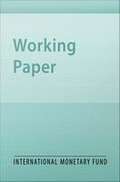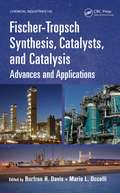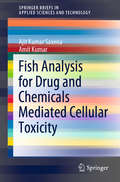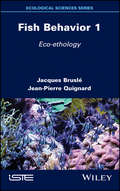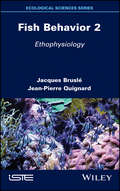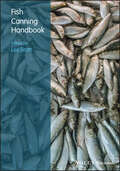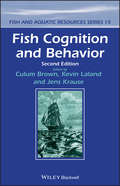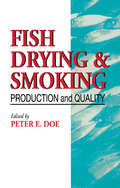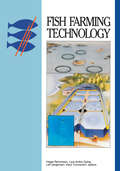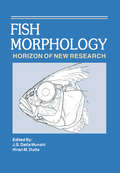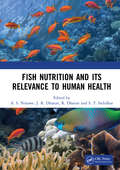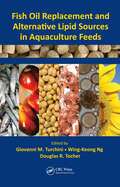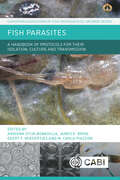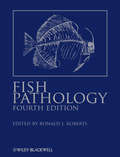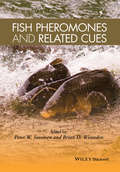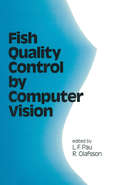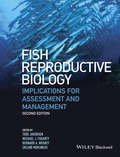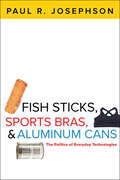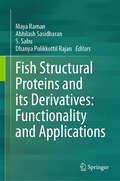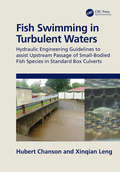- Table View
- List View
Fiscal Policy and Economic Cycles in Oil-Exporting Countries
by Aasim M. Husain Kamilya Tazhibayeva Anna Ter-MartirosyanA report from the International Monetary Fund.
Fiscal Policy in Oil Producing Countries During the Recent Oil Price Cycle
by Mauricio Villafuerte Pablo Lopez-MurphyA report from the International Monetary Fund.
Fiscal Vulnerability and Sustainability in Oil-Producing Sub-Saharan African Countries
by Robert York Zaijin ZhanA report from the International Monetary Fund.
Fischer-Tropsch Synthesis, Catalysts, and Catalysis: Advances and Applications (Chemical Industries Ser. #Vol. 142)
by Burtron H. Davis Mario L. OccelliWith petroleum prices spiraling upward, making synthetic fuels-or "synfuels"-from coal, natural gas, and biomass has become more economically competitive. Advanced energy companies now focus exclusively on alternative fuels, and many oil companies have programs dedicated to developing synthetic fuels. The Fischer-Tropsch process, which uses a colle
Fish Analysis for Drug and Chemicals Mediated Cellular Toxicity (SpringerBriefs in Applied Sciences and Technology)
by Amit Kumar Ajit Kumar SaxenaThis book offers a comprehensive overview of drug and chemical cellular toxicity, especially concerning the effects of anticancer drugs (cyclophosphamide, methotrexate and phosphamidon) on chromosomes and proteins. It covers histological changes in rat testis during pre- and postnatal exposure to varied drug doses, along with laboratory findings on arsenic exposure and alcohol consumption producing neurological changes and deleterious effects on reproductive health in animals. The book offers essential information on the role of anticancer drug- / chemical-mediated toxicity in connection with genetic changes in the brain and reproductive health, making it a valuable guide for researchers working in the areas of cancer research, infertility, molecular diagnostics and modern drug discovery, at biochemical and toxicity laboratories, and in genetic predisposition and molecular biology in general.
Fish Behavior 1: Eco-ethology
by Jean-Pierre Quignard Jacques BrusleAdvances in underwater exploration, in situ observation of fish populations, as well as the development of cutting-edge technologies, provide modern insights into behaviors and strategies of fish, whose cognitive abilities have long been underestimated and undervalued. Fish Behavior 1 presents current knowledge about fish biology, ecology and ethology. In light of the most recent scientific work, this book examines the habitats exploited by fish, as well as the strategies and tactics they have adopted regarding the occupation of available territories. It also addresses communication issues between individuals during social interactions. This book is intended for researchers, teachers, master's and doctoral students in biology and biogeography, engineers and technicians responsible for the development and protection of natural environments and public aquariums, in addition to aquaculturists, fishermen, environmentalists and ecologists.
Fish Behavior 2: Ethophysiology
by Jean-Pierre Quignard Jacques BrusleAdvances in underwater exploration, in situ observation of fish populations, as well as the development of cutting-edge technologies, provide modern insights into behaviors and strategies of fish, whose cognitive abilities have long been underestimated and undervalued. Fish Behavior 2 presents current knowledge about fish biology, ecology and ethology. In light of the most recent scientific work, this book examines topics such as their reproductive behavior and the expression of their personalities. It also addresses issues associated with neurophysiological conditioning of behaviors, in relation to the structural and functional complexity of their brains. This book is intended for researchers, teachers, master's and doctoral students in biology and biogeography, engineers and technicians responsible for the development and protection of natural environments and public aquariums, in addition to aquaculturists, fishermen, environmentalists and ecologists.
Fish Canning Handbook
by Les BrattCanning continues to be an extremely important form of food preservation commercially, and canned fish represents a source of relatively inexpensive, nutritious and healthy food which is stable at ambient temperatures, has long shelf life and in consequence is eminently suitable for worldwide distribution. It is vitally important that all canning operations are undertaken in keeping with the rigorous application of good manufacturing practices if the food is to be safe at the point of consumption. This demands that all personnel involved in the management and operation of cannery operations have a competent understanding of the technologies involved, including the basic requirements for container integrity and safe heat sterilisation. This book provides a source of up to date and detailed technical information for all those involved in the production of canned fish, from students thinking of entering the industry, to regulatory authorities with responsibility for official inspection, trading companies and retail organisations who purchase canned fish, as well as the manufacturers themselves. An exhaustive range of topics are covered in 15 chapters, including: the current global market; processing, packaging and storage operations; food safety and quality assurance; international legal requirements and laboratory analysis.
Fish Cognition and Behavior (Fish and Aquatic Resources #21)
by Jens Krause Culum Brown Kevin LalandIn the second edition of this fascinating book an international team of experts have been brought together to explore all major areas of fish learning, including: Foraging skills Predator recognition Social organisation and learning Welfare and pain Three new chapters covering fish personality, lateralisation, and fish cognition and fish welfare, have been added to this fully revised and expanded second edition. Fish Cognition and Behavior, Second Edition contains essential information for all fish biologists and animal behaviorists and contains much new information of commercial importance for fisheries managers and aquaculture personnel. Libraries in all universities and research establishments where biological sciences, fisheries and aquaculture are studied and taught will find it an important addition to their shelves.
Fish Drying and Smoking: Production and Quality
by Peter E. DoeThis book explains the current and traditional fish smoking and drying practices in terms of the basic underlying principles of biochemistry and food technology. Readers will soon become aware of the discrepancies between the basic scientific knowledge and modern technology on one hand, and the traditional processes described in some chapters. This book bridges that gap. The emphasis in this book in on the critical factors which affect the quality of products produced in less technological cultures-products which have been largely neglected in technically advanced countries-and on developments and innovations which have occurred in the last five years. The critical factors affecting the quality of fish products in technically advanced countries have been summarized. The answers to questions on the quality of smoked, cured and dried fish can be found from an understanding of the physical, chemical, and biological factors influencing the functionality of the product at every stage of its preparation and subsequent handling from the time the fish is harvested to the time it is eaten.
Fish Farming Technology
by H. Reinersten L.A, Dahle L. JorgensenOver the past few years, it has become more and more obvious that fish farming will become increasingly important in the future. As fish farming moves into its industrial phase, technology will be an important factor in determining its successful development. It is therefore important for scientists & representatives from the aquaculture industry to meet to define state of the art and explore future development of fish farming technology for different fish species. 81 papers and abstracts were presented at the conference. The proceedings reflect the different sections of the conference: the plenum sessions and three parallel sessions: Juvenile marine fish, open production plants, closed production plants and poster sessions.
Fish Morphology: Horizon Of New Research
by HiranM. DuttaTopics covered in this volume include: transformation morphology on structures in the head of cichlid fishes; the structure and function of fish liver; atretic follicles and corpora lutea in the ovaries of fishes; effects of gill dimension on respiration; and the efects of pesticides on fish.
Fish Nutrition And Its Relevance To Human Health
by A. S. NinaweThe book on Fish Nutrition and Its Relevance to Human Health is an important document in fillingthe gap of requisite fish nutrition and sustainable aquaculture in different agro-climatic zones andits relevance to human health. The book includes 14 chapters addressing various aspect of nutritionalrequirement of cultivable finfishes of freshwater, brackish water and marine eco systems includingcold water and valley region fisheries. Various aspects on larval and adult feeding with cultivation andintensification of live food organisms including copepods is discussed. Aspects on immunomodulation,role of digestive enzymes and nutraceuticals, probiotics including nutrigenomics have been welldocumented. Post harvest and value addition aspects have been the important contribution for fishfarming and human nutrition value. A topic has been included on water quality management for safehusbandry practices on bio-flock technology and its relevance for sustainable aquaculture farmingsystems in a book on fish nutrition and its relevance to human health. Note: T&F does not sell or distribute the Hardback in India, Pakistan, Nepal, Bhutan, Bangladesh and Sri Lanka.
Fish Oil Replacement and Alternative Lipid Sources in Aquaculture Feeds
by Giovanni M. Turchini Wing-Keong Ng Douglas R. TocherExperts are predicting that demand for marine fish oil will soon outstrip supply, creating extreme urgency within the global aquafeed industry to find viable alternatives. Fish Oil Replacement and Alternative Lipid Sources in Aquaculture Feeds is the first comprehensive review of this multifaceted, complex issue. It also addresses the crucial quest
Fish Parasites: A Handbook of Protocols for their Isolation, Culture and Transmission (European Association of Fish Pathologists (EAFP))
by Prof. Ariadna Sitjà-Bobadilla; Prof. James. E. Bron; Prof. Geert Wiegertjes; Dr. M. Carla Piazzon; Sean MonaghanGood fish health and welfare are essential components of sustainable aquaculture and, in this regard, fish parasites constitute a major constraint to production. The aquaculture industries of areas affected by various disease outbreaks have suffered considerably from the impacts of marine and freshwater parasites. It is therefore fundamentally important to take steps to prevent parasite infection, as well as to properly identify, monitor and treat outbreaks when they occur. ParaFishControl, an EU-funded project involving industry, academic and government partners drawn from across Europe, whose work has led to this book, is dedicated to effectively understanding and controlling a diverse range of fish parasites in order to promote the sustainability and competitiveness of the European aquaculture industry. Fish Parasites contains detailed outlines of the most up-to-date protocols for parasite isolation, culture and transmission, as well as detailed procedures for reproducing parasitic infections in a laboratory environment. Protocols for tasks such as monitoring parasitic infection, isolating parasites and preparing parasite material are explained in detail. In addition, an introduction is provided to the biology and host interactions of each parasite discussed. Fish Parasites provides an essential guide for those who are currently researching fish-parasite relations, as well as for those who may study fish health and welfare more generally or otherwise have broader interests in fish parasites.
Fish Pathology
by Ronald J. RobertsFish Pathology is the definitive, classic and essential book on the subject, providing in-depth coverage across all major aspects of fish pathology. This new, fully updated and expanded fourth edition builds upon the success of the previous editions which have made Fish Pathology the best known and most respected book in the field, worldwide.Commencing with a chapter covering the aquatic environment, the book provides comprehensive details of the anatomy and physiology of teleosts, pathophysiology and sytematic physiology, immunology, neoplasia, virology, parasitology, bacteriology, mycology, nutritional pathology and other non-infectious diseases. A final chapter provides extremely useful details of the most widely-used and trusted laboratory methods in the area. Much new infomation is included in this new edition, including enhanced coverage of any diseases which have become commercially significant since publication of the previous edition Beautifully illustrated in full colour throughout with many exceptional photographs, Fish Pathology, Fourth Edition, is an essential purchase for fish pathologists, fish veterinarians, biologists, microbiologists and immunologists, including all those working in diagnostic services worldwide. Personnel working in fish farming and fisheries will also find much of great use and interest within the book's covers. All libraries in universities and research establishments where biological and veterinary sciences are studied and taught should have copies of this landmark publication on their shelves.
Fish Pheromones and Related Cues
by P. W. Sorensen Brian D. WisendenOrganisms release pheromones into their environments to allow them to communicate with other members of their species. Pheromones are of increasing interest in both basic and applied aspects of fish biology. Fish Pheromones and Related Cues provides a timely synthesis of this growing body of pheromone research exploring everything from how these chemical signals are processed to the potential application of pheromone research on fish culture and conservation. Fish Pheromones and Related Cues opens with a useful overview of fish pheromone research. Chapters then examine the biological importance of pheromones in inter- and intraspecies communication, and the role these chemical cues play in a variety biological functions from reproduction to predation. The final chapters provide valuable insight into how pheromones are being applied in real-world efforts to culture fish species and to conserve our wild-borne populations from pollutants and invasive species. With far-reaching economic and ecological implications, Fish Pheromones and Related Cues will be an essential volume for anyone working in the fields of fish biology, aquatic conservation, ecology, and aquaculture.
Fish Population Dynamics, Monitoring, and Management: Sustainable Fisheries In The Eternal Ocean (Fisheries Science Ser.)
by Ichiro Aoki Takashi Yamakawa Akinori TakasukaThis book explores how we can solve the urgent problem of optimizing the use of variable, uncertain but finite fisheries resources while maintaining sustainability from a marine-ecosystem conservation perspective. It offers readers a broad understanding of the current methods and theory for sustainable exploitation of fisheries resources, and introduces recent findings and technological developments. The book is divided into three parts: Part I discusses fish stock dynamics, and illustrates how ecological processes affecting life cycles and biological interactions in marine environments lead to fish stock variability in space and time in major fish groups; small pelagic fish, demersal fish and large predatory fish. These insights shed light on the mechanisms underlying the variability in fish stocks and form the essential biological basis for fisheries management. Part II addresses the technologies and systems that monitor changes in fisheries resources and marine ecosystems using two approaches: fishery-dependent and fishery-independent data. It also describes acoustic surveys and biological sampling, as well as stock assessment methods. Part III examines management models for effectively assessing the natural variability in fisheries resources. The authors explore ways of determining the allowable catch in response to changes in stock abundance and how to incorporate ecological processes and monitoring procedures into management models. This book offers readers a broad understanding of sustainable exploitation as well as insights into fisheries management for the next generation.
Fish Processing: Sustainability and New Opportunities
by George M. HallThis book seeks to address the challenges facing the international seafood industry via a two pronged approach: by offering the latest information on established technologies and introducing new ideas and technologies. An introductory chapter sets the tone for the book by presenting the background against which fish processing will exist in the near future. Chapter two looks at the environmental and sustainability issues relating to conventional fish processing, including processing efficiency and better use of the outputs currently considered wastes. The impact of mechanisation and computerisation on environmental sustainability is also addressed. Subsequent chapters examine the latest developments in established fish processing technologies such as canning, curing, freezing and chilling, with an emphasis on the environmental aspects of packaging and the process itself. In addition, quality and processing parameters for specific species, including new species, are described. The second part of the book gives authors the opportunity to introduce the potential technologies and applications of the future to a wider audience. These include fermented products and their acceptance by a wider audience; the utilisation of fish processing by-products as aquaculture feeds; and the use of by-products for bioactive compounds in biomedical, nutraceutical, cosmetic and other applications.
Fish Quality Control by Computer Vision (Food Science And Technology Ser. #43)
by L. F. PauBased on a 1988-89 cooperative project by 15 industrial researchers from Denmark, Iceland, Norway, and the Faeroe Islands, explores how computer vision and image processing can be applied to such aspects of the fishing industry as the quality inspection of fish and fish products for defects; the mea
Fish Reproductive Biology
by Professor Michael J. Fogarty Dr Tore Jakobsen Dr Bernard A. Megrey Dr Erlend MoksnessFish recruitment is a key process for maintaining sustainable fish populations. In the marine environment, fish recruitment is carried out in many different ways, all of which have different life history strategies. The objective of this book is to argue for greater linkages between basic and applied research on fisheries recruitment, and assessment and management of exploited fish stocks. Following an introductory chapter, this second edition of Fish Reproductive Biology is organized into 3 main sections: Biology, Population Dynamics and Recruitment Information Critical to Successful Assessment and Management Incorporation of Reproductive Biology and Recruitment Considerations into Management Advice and Strategies The authors collectively bring a wide range of diverse experience in areas of reproductive biology, fisheries oceanography, stock assessment, and management. Fully updated throughout, the book will be of great interest to a wide audience. It is useful as a textbook in graduate and undergraduate courses in fisheries biology, fisheries science, and fisheries resource management and will provide vital information for fish biologists, fisheries scientists and managers.
Fish Sticks, Sports Bras, & Aluminum: The Politics of Everyday Technologies
by Paul R. JosephsonA revealing look at the history, politics, and social meanings behind everyday objects.Who would have guessed that the first sports bra was made out of two jockstraps sewn together or that it succeeded because of federal anti-discrimination laws? What do simple decisions about where to build a road or whether to buy into the carbon economy have to do with Hurricane Katrina or the Fukushima nuclear disaster? How did massive flood control projects on the Mississippi River and New Deal dams on the Columbia River lead to the ubiquity of high fructose corn syrup? And what explains the creation—and continued popularity—of the humble fish stick?In Fish Sticks, Sports Bras, and Aluminum Cans, historian Paul R. Josephson explores the surprising origins, political contexts, and social meanings of ordinary objects. Drawing on archival materials, technical journals, interviews, and field research, this engaging collection of essays reveals the forces that shape (and are shaped by) everyday objects.Ultimately, Josephson suggests that the most familiar and comfortable objects—sugar and aluminum, for example, which are inextricably tied together by their linked history of slavery and colonialism—may have the more astounding and troubling origins. Students of consumer studies and the history of technology, as well as scholars and general readers, will be captivated by Josephson’s insights into the complex relationship between society and technology.“Josephson’s conclusions are guaranteed to make you think of the modern world and its interconnectedness in a different light.” —Cosmos“Every chapter of this book offers surprising insights and is a pleasure to read.” —ICON
Fish Sticks, Sports Bras, and Aluminum Cans: The Politics of Everyday Technologies
by Paul R. JosephsonWhat do bananas, rocket ships, bicycles, and French fries have in common?Who would have guessed that the first sports bra was made out of two jockstraps sewn together or that it succeeded because of federal anti-discrimination laws? What do simple decisions about where to build a road or whether to buy into the carbon economy have to do with Hurricane Katrina or the Fukushima nuclear disaster? How did massive flood control projects on the Mississippi River and New Deal dams on the Columbia River lead to the ubiquity of high fructose corn syrup? And what explains the creation—and continued popularity—of the humble fish stick? In Fish Sticks, Sports Bras, and Aluminum Cans, historian Paul R. Josephson explores the surprising origins, political contexts, and social meanings of ordinary objects. Drawing on archival materials, technical journals, interviews, and field research, this engaging collection of essays reveals the forces that shape (and are shaped by) everyday objects. Ultimately, Josephson suggests that the most familiar and comfortable objects—sugar and aluminum, for example, which are inextricably tied together by their linked history of slavery and colonialism—may have the more astounding and troubling origins. Students of consumer studies and the history of technology, as well as scholars and general readers, will be captivated by Josephson’s insights into the complex relationship between society and technology.
Fish Structural Proteins and its Derivatives: Functionality and Applications
by Maya Raman Dhanya Pulikkottil Rajan Abhilash Sasidharan S. SabuThis book brings out a comprehensive collection of information on the structural proteins of fish in both marine and fresh water system. The main focus of this book is to address all relevant aspects of structural proteins of fish and its commercial significance. Fish is a rich and cheap source of protein, and the collagen and myofibrillar proteins, play a key role in food and pharmaceutical industries. Marine-based collagen due to its unique properties have fewer risks of transmitting diseases. These have low molecular weight, are biocompatible, lack religious constraints, and involves cost-effective extraction process. Therefore, it finds wide biomedical applications. The details of its extraction, isolation and characterization, supported with photographs and flow-charts are provided. This book also discusses the different peptides and derivatives of proteins that may have beneficial health significance and other commercial importance. Further, the application of bioinformatics and artificial intelligence in understanding the protein structure in-silico are also discussed in detail. This book is of interest and useful to students, academician, researchers and industrialists/ entrepreneurs, and is a valuable source of reference to the relevant researchers/ students.
Fish Swimming in Turbulent Waters: Hydraulic Engineering Guidelines to assist Upstream Passage of Small-Bodied Fish Species in Standard Box Culverts
by Hubert Chanson Xinqian LengLow-level river crossings, including culverts, are important for delivering a range of valuable socioeconomic services, including transportation and hydrological control. These structures are also known to have negative impacts on freshwater river system morphology and ecology, including the blockage of upstream fish passage, particularly small-body-mass fish species. Given the enormous environmental problems created by road crossings, new hydraulic engineering guidelines are proposed for fish-friendly multi-cell box culvert designs. The focus of these guidelines is on smooth box culverts without appurtenance, with a novel approach based upon three basic concepts: (I) the culvert design is optimized for fish passage for small to medium water discharges, and for flood capacity for larger discharges, (II) low-velocity zones are provided along the wetted perimeter in the culvert barrel, and quantified in terms of a fraction of the wetted flow area where the local longitudinal velocity is less than a characteristic fish speed linked to swimming performances of targeted fish species, and (III) the culvert barrel is smooth, without any other form of boundary treatment and appurtenance. The present monograph develops a number of practical considerations, in particular relevant to box culvert operations for less-than-design discharges. It is argued that upstream fish passage capabilities would imply a revised approach to maintenance, in part linked to the targeted fish species.This reference work is authored for civil and environmental engineers, as well as biology and ecology scientists interested in culvert design. While the book is aimed to professionals, the material is also lectured in postgraduate courses and in professional short courses.

